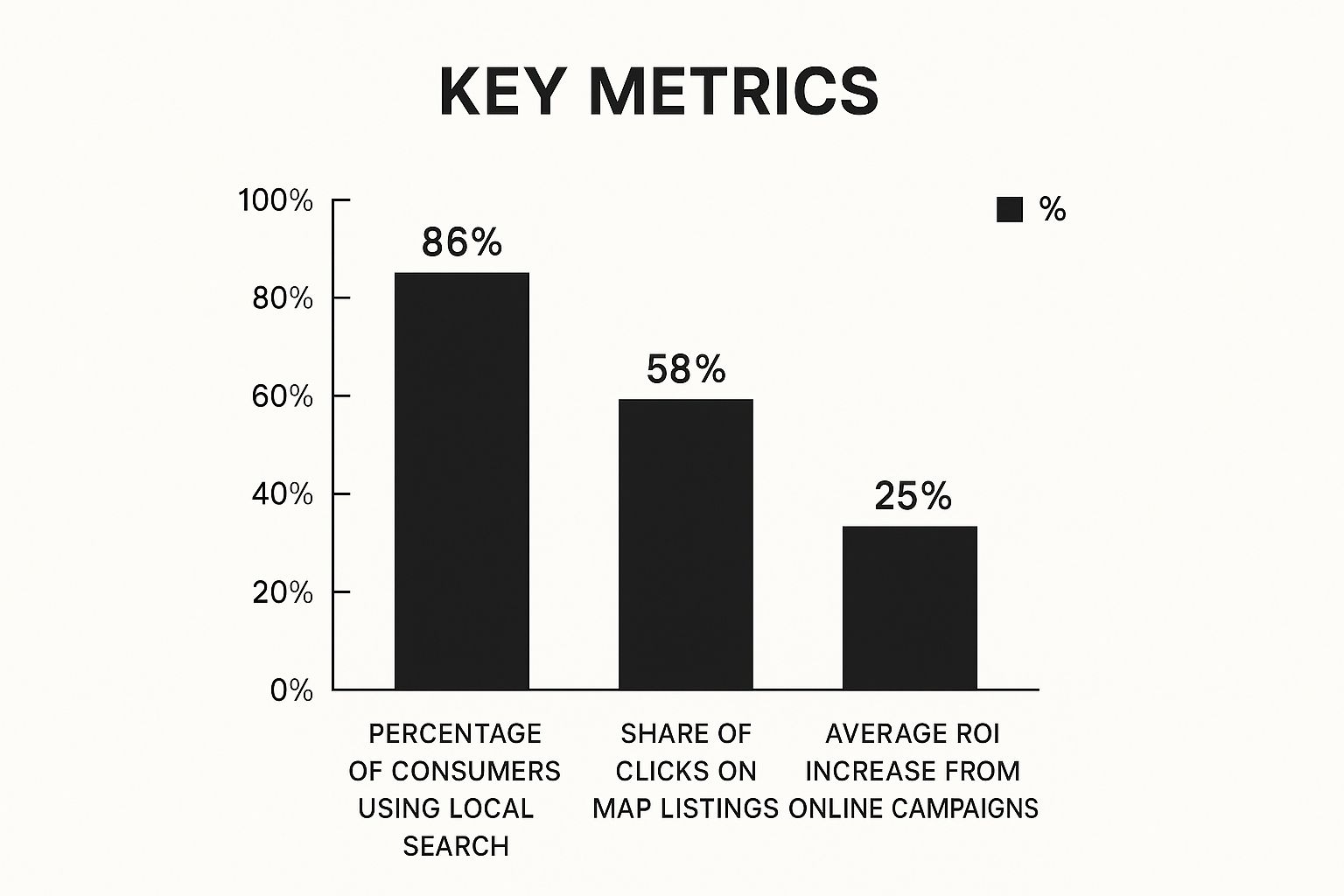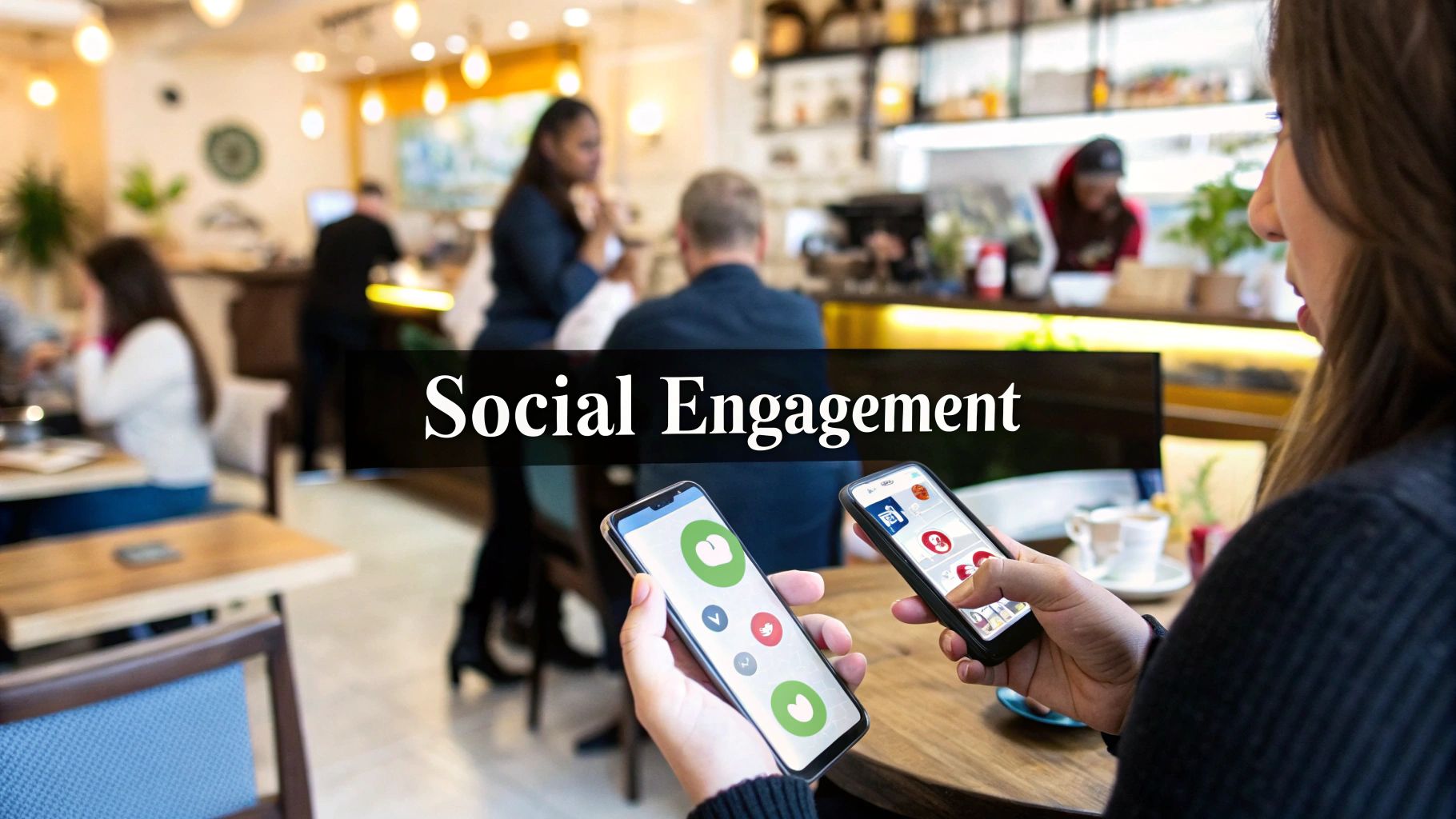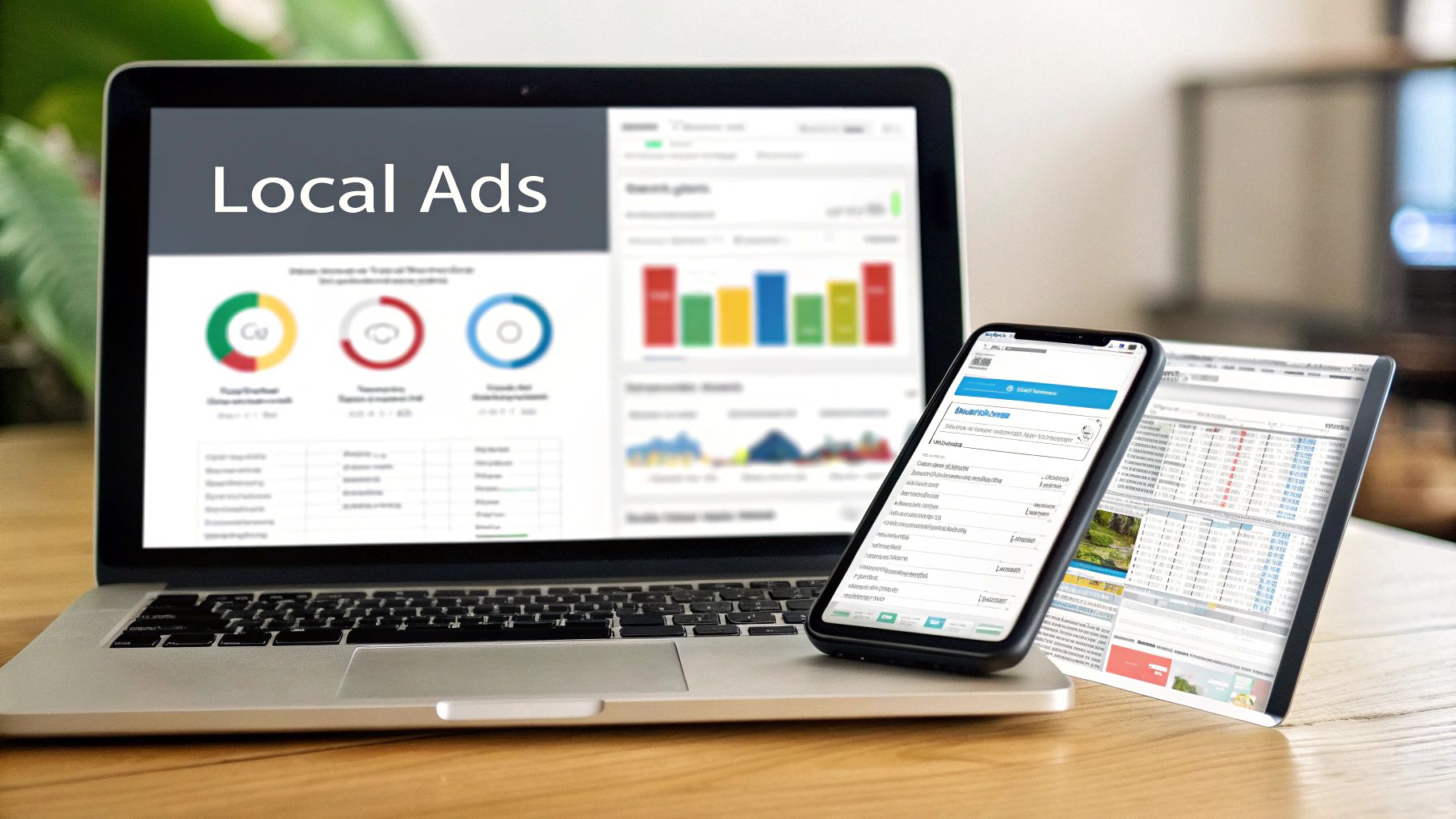Your Guide to Local Business Online Marketing

Local online marketing is all about using digital tools to get real-world customers from your specific area through the door. It’s a blend of having a solid online base—like your website and Google Business Profile—and using targeted tactics like local SEO, paid ads, and social media to grab the attention of people nearby. Boost foot traffic with this guide to local business online marketing.
Guide to Local Business Online Marketing: Building Your Digital Storefront for Local Success
Before you even think about spending a penny on ads, you need to get your online house in order. Think of it as building your digital storefront. Getting this foundation right ensures that every pound you invest in marketing and every minute you spend creating content actually pays off by making a strong, trustworthy first impression.
First things first: your website must be built for mobile. A huge chunk of local searches happen on smartphones, often when someone’s out and about looking for a quick solution. A clunky, slow-loading mobile site is the fastest way to send a potential customer straight to your competitor.
Optimise Your Core Local Listings
Your Google Business Profile (GBP) is, without a doubt, your most valuable asset for local visibility. It’s what gets you on Google Maps and into that all-important “Local Pack” at the top of the search results. To make it work for you, you need to fully optimise it with accurate hours, a precise address, great photos, and regular posts. This tells Google you’re an active, reliable local business worth showing to searchers.
But don’t stop at Google. It’s also crucial to get your business listed on other key UK directories like Yelp and Bing Places. Make sure your business name, address, and phone number (what we call NAP) are identical across every single platform. Any inconsistencies can confuse both search engines and customers.
A strong, consistent digital footprint across multiple platforms is the bedrock of any successful local marketing strategy. It builds trust and makes it dead simple for ready-to-buy customers to find and choose you.
This isn’t just theory; the opportunity in local search is massive, from getting discovered to driving clicks directly from the map.
The data speaks for itself. People aren’t just using local search; they’re actively clicking on map listings, which hammers home just how vital a well-managed GBP really is.
Nailing these foundational elements directly feeds into the main goals of most UK businesses. A solid digital storefront is the first step towards achieving all three.
Core Digital Marketing Priorities for UK Local Businesses
Recent survey data from the 2025 LOCALiQ UK State of Digital Marketing Report highlights what UK businesses are really focused on. This table breaks down their top priorities, showing where they are directing their digital efforts.
| Marketing Priority | Percentage of UK Businesses Focused on This Goal |
|---|---|
| Increasing Sales Revenue | 54% |
| Increasing Brand Awareness | 42% |
| Increasing Customer Engagement | 42% |
As you can see, driving revenue is the number one goal, closely followed by building brand recognition and engaging with customers—all of which start with a polished digital presence.
To really make your digital storefront pop and connect with your local audience, it’s worth exploring some proven small business content marketing strategies.
Mastering Local SEO to Attract Ready-to-Buy Customers
Once your digital storefront is up and running, the real work begins: getting local customers through the door. This is where Local Search Engine Optimisation (SEO) becomes your best friend. It’s a core part of any smart local business online marketing plan and it’s all about making sure you show up the very second a potential customer in your area needs what you offer.
Forget everything you’ve heard about abstract keyword theories. Winning at local SEO is about taking practical, targeted actions. It means you have to go beyond just having a generic website and start creating content that actually speaks to your community. This kind of hyper-local content sends a massive signal to search engines that you’re a key player in your specific geographical area.
Create Content Your Community Cares About
So, what does your local audience actually care about? A bland, corporate blog post about your industry simply won’t cut it. It’s not going to grab a local’s attention nearly as well as something tied directly to their neighbourhood.
Think about it. A local café could write a blog post like, “Our Favourite Dog-Walking Routes in Manchester’s Northern Quarter,” and cleverly position their café as the perfect spot to grab a coffee afterwards. Or a local builder could showcase a recent loft conversion in Didsbury with a case study titled, “Transforming a Victorian Terrace in Didsbury.”
This simple shift in thinking does two incredibly important things:
- It gives genuine value to the people living right on your doorstep.
- It naturally weaves in the location-specific keywords that real people are typing into Google.
This is how you start ranking for those high-intent local searches, like “dog-friendly cafes in Manchester” or “builders in Didsbury.” You’re not just getting traffic; you’re attracting customers who are ready to make a move.
Local SEO isn’t just about getting found online. It’s about becoming a trusted, integral part of the local scene. When you create content that reflects local life, you build an authentic connection that the big national chains just can’t compete with.
Build Trust with Citations and Reviews (Guide to Local Business Online Marketing)
Beyond creating great content, two other pillars hold up your local SEO efforts: citations and reviews.
Think of citations as digital breadcrumbs. They are mentions of your business’s name, address, and phone number (NAP) on directory sites like Yelp, Yell, and other industry-specific listings. Consistency here is non-negotiable. Your NAP details must be absolutely identical everywhere you list them, or you risk confusing the search engines.
At the same time, you need to cultivate a steady stream of positive customer reviews. These are a massive trust signal. In fact, having a high volume of recent, glowing reviews can give you a serious leg up in Google’s “Local Pack” map results. Make it easy for happy customers by sending a follow-up email with a direct link to your Google Business Profile.
Fine-Tune Your Website for Local Searches
Finally, you need to make some specific tweaks to your website itself—something we call on-page SEO. This means optimising your page titles and headings to include local search terms. Instead of a generic title like “Our Plumbing Services,” go for something specific like “Expert Plumbing Services in Bristol.”
Do you serve multiple towns? Then create dedicated landing pages for each one. A page titled “Emergency Electrician in Bath” will perform miles better for searches in that area than a single, generic “Services” page ever could. It shows both potential customers and Google that you’re serious about serving that specific community.
When you combine this strong organic foundation with a smart paid advertising campaign, the results can be phenomenal. To get a better handle on how these two work together, it’s worth learning more about integrating Google Ads with your SEO strategy.
Guide to Local Business Online Marketing: Running Smart Paid Ads for Local Impact
While Local SEO is fantastic for building your long-term organic presence, sometimes you just need to get leads and footfall right now. This is where paid advertising truly shines. For any solid local business online marketing strategy, smart paid ads on platforms like Google and Facebook can deliver immediate, targeted traffic – but only if you approach them with precision.
It’s shockingly easy to waste money showing ads to people hundreds of miles away. That’s a common and expensive mistake. The key is to think small to win big. Your most powerful tool here is geo-targeting, which lets you draw a digital fence around your service area and show ads exclusively to people inside it.
Imagine a local café in Brighton running a Facebook ad for its new lunch special. Instead of blasting it to all of Sussex, they can set the targeting to only show it to people within a two-mile radius of their postcode. This simple move ensures every penny of the ad budget is spent on potential customers who can actually pop in for a bite.
Getting Hyper-Local with Your Ad Campaigns
Precision goes way beyond just location. Your ad copy and visuals have to speak directly to local people. Mentioning local landmarks, well-known neighbourhoods, or even community events can make your ad feel far more relevant and trustworthy than a generic one from a national chain.
Think about these real-world scenarios:
- An emergency plumber in Leeds could run Google Ads specifically targeting keywords like “burst pipe help in Headingley” or “emergency plumber near Roundhay Park.”
- A boutique clothing shop in Bath could use Instagram ads to showcase its new collection to users who have recently visited or live in the city centre, using visuals that feel authentic to the area.
- A local gym in Glasgow might offer a special introductory membership only to people living in specific nearby postcodes, encouraging sign-ups from the immediate community.
This is the level of detail that separates a profitable local campaign from a wasteful one. If you’re just getting your feet wet with paid search, it’s well worth reading a beginner’s guide to PPC success to get a handle on the fundamentals before you spend a single pound.
Maximising Visibility and Budget
Modern ad platforms are built with local businesses in mind. On Google Ads, using location extensions is completely non-negotiable. They automatically add your address, a map marker, and your phone number directly into your ad, making it incredibly simple for searchers to find or call you.
Remember, the goal of local paid ads isn’t just clicks; it’s tangible actions like phone calls, requests for directions, and in-store visits. Every single part of your ad should be fine-tuned to drive these local outcomes.
The shift toward digital ad spend is undeniable. Industry data shows that over 50% of company marketing budgets are now funnelled into paid media and new technologies. With mobile advertising predicted to make up a staggering 70% of total ad spend by 2028, reaching local customers on their phones has never been more critical. This massive investment just underscores the need for a precise, well-managed paid media strategy to ensure you get a strong return.
Building a Loyal Community Through Social Media and Email
For a local business, lasting success isn’t about one-off transactions. It’s built on relationships. This is exactly where the community-building muscle of social media and email marketing flexes. These channels let you move beyond being just another shop or service and become a genuine part of your customers’ lives, turning fleeting visitors into loyal fans who keep coming back for more.
The first move is choosing the right social platforms. Don’t get caught up in the pressure to be everywhere. Instead, be smart and go where your customers already are. If you run a visually-driven business like a restaurant, boutique, or salon, Instagram is a no-brainer. For a B2B service provider, say a local accountant or IT consultant, LinkedIn is where you’ll build professional credibility and network with other local businesses.
The heart of great local social media isn’t just broadcasting your offers. It’s about sparking real conversations and showing off the personality behind your brand. That’s the kind of authenticity a national chain can never truly replicate.
This approach creates a powerful, owned marketing asset. While paid ads are crucial for getting seen, building your own email list and social following gives you a direct, unfiltered line to your most engaged customers—a line you completely control.
Content That Truly Connects With Locals (Guide to Local Business Online Marketing)
Once you’ve picked your platforms, the game shifts to creating content that actually resonates. Generic sales pitches will get you nowhere fast. Your mission is to foster a sense of belonging and provide genuine value.
Here are a few content ideas we’ve seen work wonders for local businesses:
- Run a Local Photo Contest: Get your followers involved by asking them to share photos of them enjoying your product or visiting your spot with a unique hashtag. A local coffee shop could run a #BestBrewInBristol contest, with a gift card for the winning shot. It’s simple, engaging, and generates fantastic user content.
- Feature Your Customers: With their permission, of course, share photos or stories of your happy customers. This is potent social proof and makes your other followers feel seen and valued.
- Go Behind the Scenes: Pull back the curtain and show the people and processes that make your business special. A local bakery could share a quick video of them pulling the morning’s fresh bread from the ovens. People love that stuff.
Growing and Nurturing Your Email List
While social media is brilliant for engagement, nothing beats email marketing for driving direct sales and nurturing loyalty. Building your email list should be a massive priority. You can collect emails right in your shop with a simple sign-up sheet at the till or by running an online competition.
Once you have subscribers, treat that list like gold. Send out a monthly newsletter packed with exclusive deals, helpful advice related to your industry, and updates about your business. For example, a local garden centre could send out seasonal planting tips. This strategy provides consistent value, keeping your business top-of-mind and strengthening that customer relationship over time. The same principles that drive traffic from paid search can also supercharge your email strategy; for more ideas, check out our insider hacks for driving traffic and sales.
Guide to Local Business Online Marketing: Creating a Seamless Customer Journey
Your customer’s experience with your brand needs to feel connected and make sense, whether they first stumble upon you on Google, spot an ad on Instagram, or land directly on your website. Nailing this smooth, unified journey is a massive part of modern local business online marketing. Why? Because it builds the kind of trust and loyalty that sets you apart from the big, faceless competitors.
Think about it from your customer’s point of view. They see a great Facebook ad for your local shop, click through to a landing page on your website built specifically for that offer, and maybe get a follow-up email with a discount a few days later. Every single step should feel like a natural continuation of the last, with consistent branding, tone, and messaging.
Mapping the Customer Path
To pull this off, you need to start thinking like a cartographer and map out the likely paths a customer might take to find you. This doesn’t have to be a huge, complicated project. Just grab a piece of paper and sketch out the most common ways people discover and interact with your business.
For example, a typical journey for a local pizza place might look something like this:
- Discovery: A potential customer searches “best pizza in York” and your Google Business Profile pops up.
- Consideration: They click through to your website to check out the menu and scan a few reviews.
- Action: They easily find your phone number or online ordering link and place an order.
- Follow-up: After their meal, they get an email inviting them to join your loyalty club for a discount on their next purchase.
By mapping these touchpoints, you can quickly spot any glaring gaps or inconsistencies. Does your website’s design match your social media profiles? Is the deal mentioned in your ad front and centre on the landing page? Fixing these small disconnects makes every interaction feel deliberate and professional.
A seamless journey reinforces a customer’s decision to choose you at every single step. It’s the digital equivalent of a warm welcome, excellent service, and a friendly farewell, all rolled into one cohesive experience.
Unifying Your Marketing Channels
This joined-up approach, often called an omnichannel strategy, is completely changing how UK businesses hold onto their customers. In fact, recent analysis shows that companies using these integrated campaigns achieve a 90% higher customer retention rate compared to those stuck with isolated, single-channel tactics. This is especially important for local businesses that need to offer a superior, personalised experience to compete.
Of course, to see how these different channels are performing and working together, you need solid data. Tools like Google Analytics are absolutely essential for tracking how users move through your website and which marketing efforts are driving real, valuable actions. If you want to get to grips with it, have a look at our comprehensive guide to understanding Google Analytics. By analysing this data, you can fine-tune each step of the journey and make sure your marketing budget is delivering measurable results.
Your Local Online Marketing Questions Answered
Jumping into local online marketing can feel like a minefield, especially when you’re busy running your actual business. I get it. Over the years, I’ve heard the same questions and seen the same hurdles trip up countless business owners.
So, let’s cut through the noise. Here are some straight answers to the most common questions I hear, with practical advice you can actually use to make smarter decisions about your marketing budget.
How Much Should a Small UK Business Budget for Marketing?
There’s no magic number here, but a solid rule of thumb for a small UK business is to set aside 7-12% of your total revenue for marketing. If you’re just starting out or you’re in a hyper-competitive space, like a busy city centre, you’ll definitely want to lean towards the higher end of that scale.
The trick is to start small and be laser-focused. What’s your number one goal right now? Is it getting the phone to ring, or just getting your name known around town? Put your initial budget into one or two channels that directly tackle that main objective.
For example, if you need leads today, Google Local Ads are a brilliant place to start. Track your return on investment like a hawk. As soon as a channel starts making you money, reinvest those profits to scale things up.
Think of your marketing budget as an investment, not a cost. Start smart, measure everything, and let the data tell you where to put your money next. This is the bedrock of any local marketing strategy that actually works.
What Is the Best Online Channel for a Local Service Business? (Guide to Local Business Online Marketing)
For most local service businesses—I’m talking plumbers, electricians, decorators, you name it—the one-two punch of Local SEO and Google Ads is almost always the best place to start. It’s a killer combination.
Why? Because your customers are on Google, right now, actively looking for what you do. They often have an urgent problem they need solving.
Showing up for searches like “emergency electrician near me” or appearing on the Google Maps pack puts you right in front of people who are ready to buy. Those Google Local Service Ads, the ones with the little “Google Guaranteed” badge, are especially powerful. They build instant trust. While social media is great for showing off your work, the direct, high-intent nature of search will almost always deliver faster, more tangible results.
How Long Does Local SEO Take to Show Results?
Patience is a virtue with Local SEO. It’s a marathon, not a sprint. You can see some quick wins—fully optimising your Google Business Profile, for instance, can move the needle in a few weeks. But to really climb the rankings for competitive local searches, you’re realistically looking at 3 to 6 months of consistent effort.
That timeline depends on a few things: how competitive your local market is, the current state of your website, and how committed you are to building local citations and getting customer reviews. The real payoff, though, is that the results stick around. Unlike paid ads that vanish the second you stop paying, good SEO work compounds over time. It builds on itself to create a reliable, organic flow of customers for years to come.
For a wider view on how all these marketing pieces fit into the bigger picture, you can find some comprehensive digital marketing tips for small business to help round out your strategy.
Ready to stop wasting money on ads that don’t work and start getting real, measurable results? The team at PPC Geeks are experts in creating data-driven campaigns that drive local leads and sales. Get your free, no-obligation PPC audit today and see how we can help your business grow.
Author
Search Blog
Free PPC Audit
Subscribe to our Newsletter
The Voices of Our Success: Your Words, Our Pride
Don't just take our word for it. With over 100+ five-star reviews, we let our work-and our satisfied clients-speak for us.
"We have been working with PPC Geeks for around 6 months and have found Mark and the team to be very impressive. Having worked with a few companies in this and similar sectors, I rate PPC Geeks as the strongest I have come across. They have taken time to understand our business, our market and competitors and supported us to devise a strategy to generate business. I value the expertise Mark and his team provide and trust them to make the best recommendations for the long-term."
~ Just Go, Alasdair Anderson




